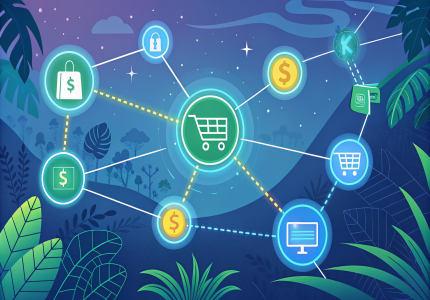
Hybrid Cryptocurrency Exchange
ICO (Initial Coin Offering)
Initial Coin Offering (ICO) is a way to attract investments into blockchain-based projects by selling tokens.
ICO is an innovative and powerful tool for raising investments for blockchain-based projects and has become a popular method for startups and companies looking to raise funds for their projects without attracting traditional venture capitalists, investment funds, or banks.
How does an ICO work?
1. The project develops an idea they plan to implement and creates a whitepaper. This document describes the project's concept, technical details, goals, team, and plans for the use of raised funds. The conditions of the ICO are determined, including the number of tokens issued, the price of tokens, and the campaign timeline.
2. The rules for conducting the ICO are announced before the actual fundraising begins. The team may set a time frame for the offer or establish a hard cap — a limit on the number of tokens sold. The project may also introduce a whitelist where users must register before participating in the ICO.
3. The project begins to actively promote its ICO, attracting potential investors through social networks, cryptocurrency forums, and specialized websites. Presentations, webinars, and other events are held to attract investors.
Initial Coin Offerings can be organized in different ways. Sometimes the project team has a blockchain that will be developed soon. In this case, users can buy tokens that are immediately sent to their addresses in the blockchain. If the project does not have its own blockchain, the tokens will be issued on an already existing third-party blockchain platform.
4. At the pre-announced time, the sale of future tokens begins. Investors can purchase tokens by sending cryptocurrency to the address specified by the project.
In return for their investments, investors eventually receive tokens that can be used in the project's ecosystem or sold on cryptocurrency exchanges.
After the ICO is completed, the funds raised are used to implement the project according to the plans outlined in the whitepaper.
The project continues to develop, and the tokens can be used in its ecosystem or traded on the secondary market.
Advantages of ICO
ICO provides startups and projects with the opportunity to raise significant amounts of funds without the need to go through the complex procedures of traditional financing.
Anyone with internet access and cryptocurrencies can invest in an ICO, making this fundraising method accessible to a wide audience.
Successful ICOs can bring significant profits to investors, especially if the project quickly develops and its tokens increase in value.
Key differences between ICO and IEO
Initial Coin Offering is very similar to Initial Exchange Offering (IEO). The key difference between them is that an IEO is conducted not only by the project team but in collaboration with a cryptocurrency exchange.
Partnership with the exchange allows users to buy tokens directly on the exchange's platform, whereas an ICO is always a 'solo venture,' without the involvement of the exchange. Token issuers will address the listing of these tokens as the next step in their development strategy.
Organizing payment acceptance for tokens during the ICO process
One of the issues that need to be addressed when organizing an ICO is arranging the acceptance of transfers from future token holders. The token issuer needs to connect a payment method to their website where they organize the sale of their future tokens. This means the issuer needs to connect a 'merchant' that will allow them to accept a wide range of popular cryptocurrencies such as BTC, ETH, USDT.
We offer issuers organizing an ICO to connect to the merchant of our system. Choosing the New Reality merchant provides you with a range of opportunities and advantages that other payment aggregators and merchant systems do not offer.
Our platform offers a very simple and convenient integration of a payment widget, which can be quickly installed on your website and allows the issuer to start selling their future tokens as quickly as possible.
We support the acceptance of all popular and promising cryptocurrencies and continuously work on adding new crypto assets used by the community as units of account.
Our merchant supports the acceptance of not only globally recognized cryptocurrencies but also allows you to accept payments with still unknown custom tokens from a list you configure yourself.
The merchant of our platform supports a scheme of trust/partnership relationships between token issuers and online platforms, marketplaces, and e-shops, allowing the seller to enable support for accepting the issuer's token as payment with one click, if they have or plan to have trust or partnership relationships.
By connecting your ICO project to our system, you can also organize the issuance of your token on our tokenization platform, allowing you to later place the tokens on our exchanges (HC Exchange and P2P Exchange) and organize the circulation of your tokens, their purchase, and sale through our network of ATMs.
By connecting your project to our merchant service, you can also organize the acceptance of payments for future tokens through the New Reality GC ATM network.
Thus, setting up payment acceptance through the merchant of our platform allows you to accept payments for tokens in all popular currencies and is a step towards building a fundamental system for circulating your crypto assets within our ecosystem.
To connect your project to the merchant of our platform, you need to register and register your site as an e-shop. Detailed instructions on how to do this are provided here:
Next, you need to follow the steps described in the instructions, copy the payment widget code, and install it on your site, as well as configure the currencies you accept. To place your tokens on our platform's exchange or in our ATM network, use the listing applications:
You may find useful:
- Issuer's personal account
- Instructions for registering and setting up an online store
- Merchant protocol description
- Application for listing tokens on the platform exchange
- Application for organizing an ICO in the ATM network
- Platform fees
IDO/IEO
What is an IDO (Initial DEX Offering)?
An Initial DEX Offering (IDO) is a fundraising method for blockchain projects where token sales are conducted through a decentralized exchange (DEX). Unlike an Initial Exchange Offering (IEO), where sales are conducted through centralized platforms, an IDO takes place on decentralized, unregulated platforms.
How does an IDO work?
1. Choosing a decentralized exchange: The project selects a decentralized exchange to conduct the IDO. These platforms do not require the involvement of a central management authority.
2. Preparation and agreement: The project develops tokens for the IDO. The project also prepares a whitepaper detailing goals, technical aspects, and plans for the use of funds.
3. Marketing and promotion: The project begins a marketing campaign to attract investor attention. This involves social media, cryptocurrency forums, webinars, and other channels.
4. Conducting the IDO: At the pre-announced time, token sales begin on the selected decentralized exchange. Investors can purchase tokens by sending cryptocurrency to the smart contract address. All transactions occur directly between users' wallets without a central intermediary.
5. Token listing: After the IDO concludes, the tokens are automatically listed on the decentralized exchange, allowing investors to start trading them immediately. This ensures token liquidity and simplifies their further use.
What is an IEO (Initial Exchange Offering)?
An Initial Exchange Offering (IEO) is a fundraising method for blockchain projects where token sales are conducted through a centralized cryptocurrency exchange.
Unlike an Initial Coin Offering (ICO), where tokens are sold directly to investors by the project, an IEO involves a centralized exchange acting as an intermediary and organizer of your coin and token sales.
How does an IEO work?
1. Choosing an exchange: The project that wants to raise funds through an IEO selects a cryptocurrency exchange to host their token sale.
2. Agreement on terms: The project and the exchange agree on the terms of the IEO, including the number of tokens to be sold, their price, the duration of the sale, and other important details.
3. Marketing campaign: The exchange and the project jointly conduct a marketing campaign to attract investor attention. The exchange uses its channels and resources to promote the IEO to its user base.
4. Conducting the IEO: At the pre-announced time, token sales begin on the exchange platform. Investors can purchase tokens using their accounts on the exchange. All transactions go through the exchange, providing additional security.
5. Token listing: After the IEO concludes, the tokens are automatically listed on the exchange, allowing investors to start trading them immediately. This ensures token liquidity and simplifies their further use.
Thus, the key difference between an ICO and an IDO/IEO lies in the methods of attracting investor funds. In an ICO, the issuer acts alone, while in an IDO or IEO, they use tools offered by or collaborate with a cryptocurrency exchange.
The Best of Both Worlds: Hybrid Cryptocurrency Exchange
We offer issuers and token offerers the opportunity to issue tokens and initially list them on our exchange.
Our platform is a Hybrid Cryptocurrency Exchange that combines the best features and properties of both centralized and decentralized exchanges.
You can read more about our exchange and the differences between CEX and DEX exchanges here:
Advantages of Our Platform:
+ High performance and low latency
+ Wide range of features and tools
+ Support for fiat currencies
+ Ease of use
+ Customer support and dispute resolution options
+ Transparency and immutability: All transaction information is stored on the platform's blockchain.
+ Asset control: Users retain control over their funds.
+ No third party in transactions: Transactions are executed automatically between users.
+ Security: The platform provides a wide range of security tools.
+ User convenience: We offer both web interfaces and mobile applications, making the trading process simple and accessible for all user categories.
+ Regulatory compliance: We are a registered crypto services provider.
+ Unified ecosystem: Our exchange is part of a unified ecosystem with other tools of our group of companies, including ATMs.
+ Compatibility: Crypto assets issued on our token issuance platform can not only be traded on the exchange but also distributed through our own ATM network.
+ Legitimacy: Our platform complies with legal requirements, supports KYC and AML policies, ensuring the legal legitimacy of the activities of investors, issuers, traders, and other users.




